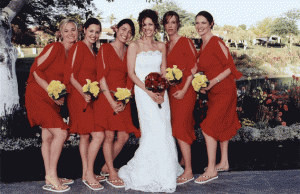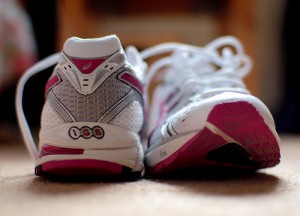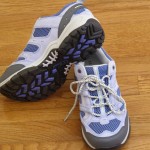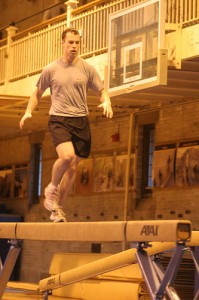Flip-Flops
The new black, these “shoes” are considered a year-round staple to any wardrobe. Their popularity has escalated over the past several years, expanding the line to include everything from the traditional rubber styles (from the old days when only worn at the beach) to fur-trimmed, bejeweled versions. Worn with suits (of both bathing and business nature), jeans, and wedding gowns, there seems to be no locale where flip-flops aren’t welcome. However, habitual use can be an orthopedic and podiatric nightmare.

But, it’s summertime. Tired of hibernating in slippers and fluff-lined boots during the colder months, your feet are anxious to be free. Perhaps you also want to show off a fancy pedicure. Flip-flop if you must, but follow these guidelines:
- Never wear flip-flops while exercising or playing sports. Even a casual game of volleyball on the beach can result in a sprain, strain, or fracture from their lack of support and cushioning.
- If you plan to walk any substantial length, skip the flip. A jaunt to the mailbox or down the street is fine. However, a night on the boardwalk, a trip to the museum, or any outing that requires you to be on your feet should be treated to a real pair of shoes (i.e., ones with a supportive base).
- If you’re suffering from an orthopedic issue like an arthritis flare-up, a backache, or tired muscles, limit your flip-flop wearing until symptoms ease. When upright, the entire skeletal system rests on your feet. Provide them with shoes worthy of this task.
- Wear flip-flops for short periods of time, not all day. Experts suggest to replace every three or four months.
Research has proven that flip-flops actually alter the wearer’s gait. This change in body mechanics can lead to painful conditions, such as plantar-fasciitis (aching and swelling of the bottom of the feet, pain specifically in the heel) and metatarsalgia (signaled by irritation and inflammation in the balls of the feet). Beyond affecting the feet and ankles, this shift in gait can trigger problems in the knees, hips, and back. It can also exacerbate previously existing conditions.
For a cool shoe alternative when the weather is hot, tuck toes into an athletic sandal. These are increasing in availability as athletes take to the mountains, beaches, and trails during warm-weather months. They often sport a cushioned sole, arch support, and waterproofing—all of which protect happy feet.
Toning Shoes
Let’s demystify this latest footwear rage. As avid exercisers, we know that building a better body takes effort, time, and commitment. It’s a process. Proper nutrition combined with a customized fitness plan gets results. Commitment to this healthy lifestyle leads to an impressive physique and a positive mind. Making that journey in shoes marketed as a “wearable gym” does not create shortcuts.

Despite the hype, an independent study sponsored by the American Council on Exercise proved toning shoes as yet another gimmick. The toning shoes did not result in improved calorie burning or muscle activation. Participants in traditional sneakers performed statistically equal.
Desperate to lose weight, shape up, and feel good fast, many consumers are anxious for a quick fix. With tight schedules and growing obligations, a toning shoe seems the perfect solution for multitasking fitness. And, they’re not the only contraptions being sold today that promise to tone the body by merely wearing them. However, the placebo affect thrives in this instance. A new pair of workout shoes in themselves, especially ones touted to tone, can be the motivation needed to intensify your exercise routine. This does, indeed, get results.
Sole Mates
Treat your feet to at least one pair of supportive, comfortable shoes in addition to those you wear at the Center. Make sure this everyday performance shoe provides good arch support, allows the foot to breathe with features like leather uppers, and has a flat, well-cushioned base. Your feet’s arches play an important role in how your body adapts to different walking surfaces. Choose ones that accommodate your arch type: flat, high, or natural.
Assure proper fit by measuring both feet at each shopping trip. Size will change slightly throughout life. Make sure there is about half-inch space from the largest toe to the shoe’s tip. The toe box should allow you wiggle room.

When choosing an exercise shoe, consider your fitness routine. Sneakers come in sport-specific varieties and are crafted accordingly. A basketball sneaker can’t crossover to be a proper walking shoe. Consider shopping at a sporting goods store or specialty shoe shop for exercise sneakers.
Knowledgeable salespeople can provide insight on style and size, both length and (often overlooked) width. Bring your old sneakers with you. Telltale wear signs can offer buying tips for replacement pairs.

Daily participation in the Human Race Olympics demands we chase down trains and school buses, lug briefcases and bags, push shopping carts, and accomplish the occasional 50-yard bathroom dash with a potty-training tot. Wear a shoe that delivers. Staying grounded and balanced is a common challenge to any modern lifestyle. Your shoes shouldn’t make it a physical impossibility as well.
Sources
“Flip-flops Can Alter Your Gait,” Carol & Richard Eustice at www.about.com.
“Toning Shoes Fail the Test,” Wendy Bumgardner at www.about.com.
“Walking Shoes: Features and Fit that Keep You Moving” at www.mayoclinic.com.
Image Credits
Wedding: www.advantagebridal.com/flflsabandsl.html. Advantage Bridal offers a vast selection of wedding flip-flops, including personalized bridesmaid flip-flops and hand-decorated bridal sandals.
Running shoes: www.flickr.com/photos/weglet/4550610136
Across the beam: www.flickr.com/photos/west_point/4365999372
 Fitness & Wellness News Your Source for Fitness News, Wellness News, Health News, and Nutrition News!
Fitness & Wellness News Your Source for Fitness News, Wellness News, Health News, and Nutrition News!



